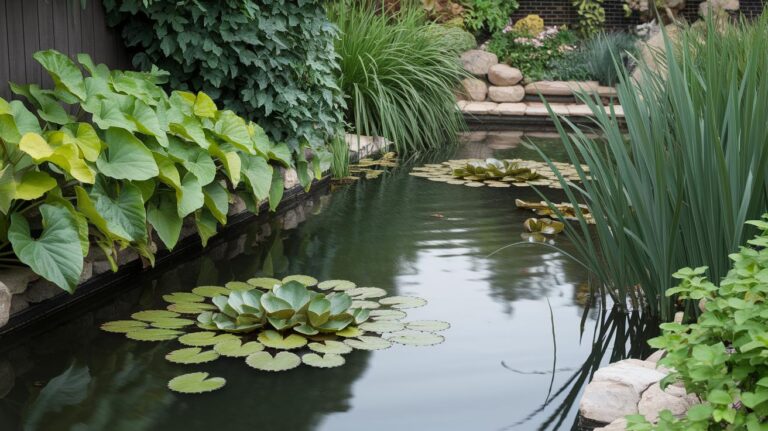Garden Edging Transforms Borders Effortlessly
Ever looked at your flower beds and felt grass sneaking in on your tulips? I have. Oops, there goes another clump.
Edging feels like drawing a chalk line between your lawn and blossoms. It gives each area its own space and keeps things tidy. Have you tried it yet?
I pushed that bendy ribbon into the warm earth (soil, the top layer where roots live), and the ground crumbled between my fingers. It really felt like framing my favorite daisies.
Just tuck plastic edging strips into a shallow trench and press them down. You’ll carve neat borders, stop runaway roots, and steer rainwater away. All without breaking much of a sweat, you know.
Garden Edging Benefits and Why It Matters
Think of garden edging as sketching a neat line between your lawn and your flower beds. It’s like telling the grass, “Hey friend, this is your side.” And if you’re into curves, edging helps you draw soft waves instead of stiff lines, no sweat.
Once I slipped those edging strips into a shallow trench, I felt like I was carving a little path for my plants. Back to the good stuff: edging makes mowing and trimming feel way easier. You’ll spend less time wrestling with your mower and more time enjoying the warm earth crumbling between your fingers.
Here’s what you get:
- Crisp mowing and trimming lines slice your yard work in half
- Holds mulch (shredded bark or leaves that protect soil) and soil where you place it, so beds stay neat
- Built-in root barrier (a strip that stops roots from sneaking under) keeps plants from invading your lawn
- Prevents soil erosion (when rain washes soil away) and guides water runoff away from fragile plants
- Shows off flowers, shrubs, or veggies as the real stars of your yard
Edging comes in metal, wood, plastic, stone, and more. You can match it to your home’s style. And whether you want straight edges or gentle curves, you’ll get that polished, just-right look that makes neighbors pause and smile.
Popular Garden Edging Materials Compared

Metal Edging
Steel panels feel solid under your fingertips. They come in 4, 6, or 12 inch heights with hemmed edges to keep your hands safe (oops, I once grabbed one too fast). The powder-coated finish fights rust so they last season after season. Each pack has five strips that interlock with spikes, no digging required. They flex around curved beds or stay rigid for straight rows.
Plastic Edging
Plastic edging bends like a ribbon twisting in your hands. It arrives in a 20 foot coil with little teeth and anchoring stakes. You can cut it to fit curves or straight lines. It’s super easy to install by yourself and you can move it each season. Try tucking in low growing flowers or stones to soften its look.
Wood Edging
Wood edging brings a warm, cozy vibe to your garden. You can choose cedar (which resists rot) or pressure-treated lumber for natural borders. Most kits include 30 inch pieces and connector pins that lock up to 20 feet. They keep your mulch where it belongs and make beds look neat. I love the fresh cedar scent on a sunny morning.
Stone & Brick Outlines
Stone or brick edging feels like a row of little walls. You can pick precast scalloped strips, log-style blocks, or brick pavers for herringbone or zigzag patterns. Laying them means digging a shallow trench, leveling each piece, then tapping down with a rubber mallet. By the way, my cat loves walking along the stones. If you need inspiration for natural stone and gravel borders, check out rock garden ideas.
Rubber Edging
Rubber edging made from recycled tires is one of the most eco-friendly choices around. No trenching needed, just drive in the stakes. It stays smooth under your mower and flexes instead of cracking when frost hits. And since it comes in black or brown, it just disappears behind your plants.
DIY Garden Edging: Step-by-Step Installation Guide
-
Mark your garden’s edge.
Grab spray paint (bright color), garden rope, or small stakes. Walk the line, tweaking curves until it feels right in your yard layout. Have you ever let string dance across the lawn? It’s kinda fun. -
Dig a trench (narrow ditch) about 3 to 4 inches deep using an edging shovel or trenching spade. Feel the cool soil crumble between your fingers as you go. By the way, my cat loves sunning on the trench edge while I work. Keep the bottom nice and level so each edging piece will sit straight.
-
Slide in each edging piece, the plastic or metal strips, so the top edge sits flush with the ground. Tap gently with a rubber mallet until it feels snug but not bent. A crisp line makes your garden pop.
-
Secure it every 18 to 24 inches with anchor stakes or spikes for metal and plastic, or pegs for rubber edging. Glove up, those spikes bite if you’re not careful. Oops, I learned that the hard way.
-
Connect the sections. Align each piece, then push in the little pins or clips until you hear that satisfying click. No seams means a neat, unbroken border.
-
Backfill the trench edges with soil or small gravel. Press down with your foot to pack it tight. This stops sections from shifting and guides water away from your plants.
-
Trim any excess with garden shears or a fine-toothed saw. Cut at angles to hug curves, then press the trimmed edge back into the trench. Perfect fit.
-
Add mulch (decayed bark or leaves), decorative stones, or low-growing ground cover as finishing touches. These little accents hide seams and add your own style.
Or skip digging entirely by tapping in plastic coils or interlocking rubber strips with built-in stakes, just align, tap into firm ground, and you’ve got a neat border in minutes.
Garden Edging Design Ideas and Patterns

-
Brick or metal straight lines give your garden a neat, formal edge. Touch the smooth border and feel how it frames your plants like a picture. It’s like framing a favorite photo. These clean lines bring modern style and classic charm together.
-
Interlocking stone (stones that fit together) or flexible plastic curves hug garden beds like a dancing ribbon. You can cut and bend each piece to fit your own shape. And, um, don’t be shy to tweak the curves until they feel right. These soft swoops echo how plants grow.
-
Try zigzag brick or paver (flat stones used for paths) patterns for a playful twist. The sawtooth edges draw your eye along the bed and contrast lush blooms. It’s a fun shape to break up straight lines. Instant garden personality.
-
Scalloped concrete or rubber strips carve soft half-circles around your beds. Tuck in ground covers (low-growing plants that spread) so they peek through each curve. It feels like a cozy cottage scene. Storybook charm, right?
-
Slender steel strips powder-coated in black or finished in corten rust (weathered steel) slice through green like an artist’s brush. Powder-coating (paint baked on for protection) keeps them looking sharp season after season. Simple. Sleek. Perfect for modern spaces.
-
Mix chunky stone blocks with gravel (small rocks) or painted bricks for bold color pops. The rough blocks and smooth pebbles play off each other. Depth and contrast make your border a real showstopper. No more plain edges.
Combine straight lines, curves, and scallops in one project to craft a border that’s uniquely yours. Play with these shapes until each edge feels like a personal accent under your plants. Which style will you try first?
Garden Edging Cost Estimates and Budget-Friendly Solutions
Here’s a quick breakdown of per-foot edging cost estimates so you can match your budget with the right material:
- Plastic edging: $0.50–$1.50 per linear foot
- Metal edging: $2–$4 per linear foot
- Rubber edging: $1.50–$3 per linear foot
- Wood edging: $2–$5 per linear foot
- Stone DIY: $8–$12 per linear foot
- Concrete or brick (installed): $10–$15 per linear foot
Professional labor typically runs $20–$30 per hour, and renting tools or buying a kit adds around $10–$20.
To save on premium finishes or bulk installations, look for wholesale options that can cut material costs by up to 20 percent. Many edging kits include connector pins, spikes, or stakes, so you avoid extra trips to the hardware store.
Choosing a DIY approach with plastic or rubber strips is one of the most budget-friendly solutions, especially when you already own basic tools like a rubber mallet and trenching spade. And if you only need a small border, shop sample packs instead of full coils to keep upfront costs low.
Garden Edging Transforms Borders Effortlessly

Hey neighbor, wanna keep your garden looking neat all year? A quick routine can give you crisp edges that make your plants pop! Just a few checks now and then keeps those borders secure and gap-free. By the way, I once spilled my potting mix – oops, that was messy!
- Quarterly inspection: walk along the edging strips, re-level any that lean, and swap out broken stakes (wooden or metal rods) and connector clips.
- Spring reset: tap frost-lifted edges back with a rubber mallet, then refill the trench with fresh soil (loose earth that nourishes) or small gravel.
- Summer maintenance: carefully trim grass along the border before each mow, and spread a two-inch layer of mulch (decayed bark that feeds soil) to keep weeds at bay.
- Annual check: brush on a rust-resistant sealant for metal edges, or treat cedar and pressure-treated wood with a protective oil (waterproof finish) to fend off rot and fungi.
- Weed barrier setup: slide landscape fabric (woven weed blocker) under the edging when you install it, or tuck it under shallow soil later to stop sneaky weeds.
Stick to this plan and you’ll have a sharp garden frame with less elbow grease. Your borders will stay true to form, and you can get back to enjoying those blooms instead of chasing gaps.
Tools & Materials
Let’s start by grabbing everything you’ll need.
Tools
- Edging shovel or trenching spade (a skinny shovel for carving neat trenches)
- Rubber mallet (a soft tap that won’t dent your edging)
- Level (to check your border sits perfectly flat)
- Tape measure (so your lines stay straight)
- Gloves (to keep your hands clean and safe)
- Eye protection (optional – safety glasses to guard your eyes from flying dirt)
Kit components
- Edging strips (flexible borders that shape your garden beds)
- Stakes (slim rods that hold strips snug in the soil)
- Connector clips (tiny clips that snap strips together without fuss)
- Landscape fabric (a breathable cloth that blocks weeds but lets water through)
Final Words
Dig right into neat lawn lines and cleaner beds. We showed why edging stops grass from sneaking into your flowers and trims your maintenance time.
We compared metal, plastic, wood, stone and rubber to suit every style. Then we walked you through a simple DIY setup, from marking borders to tapping in stakes.
Pattern ideas, budget scorecards and upkeep tips are all in your pocket. Your yard will thank you for embracing garden edging and that fresh, neat border.
FAQ
What is the cheapest way to edge a garden?
The cheapest way to edge a garden is with budget-friendly materials like plastic borders or recycled rubber strips. Both snap into the soil with stakes and work well for straight or curved layouts.
What materials are available for garden edging?
Popular edging materials include metal strips for a sleek line, plastic borders for curves, wood posts for raised beds, stone or brick for a classic look and recycled rubber for a soft edge.
What type of garden edging is best?
The best garden edging type depends on your style and function. Metal strips offer a sleek edge, stone or brick bring a classic look, and wood adds warmth. Pick what matches your yard.
What are common mistakes when edging?
Common edging mistakes include digging trenches too shallow or deep, leaving gaps between sections and skipping backfill. Plus uneven heights or skipping grass trim will keep your border from looking crisp.
How much will 100 feet of edging cost?
100 feet of edging can cost from $50 for basic plastic to over $1,500 for installed brick or stone. Expect $100–$400 for mid-range materials like metal, wood or concrete block only.
Where can I buy garden edging materials?
Garden edging materials are sold at home improvement stores like Lowe’s, Home Depot, local garden centers or online retailers. Check store websites to view availability and compare prices before you visit.
What are creative garden edging ideas?
Creative edging ideas include scalloped concrete strips for cottage charm, zigzag brick patterns for visual interest, gentle curves with interlocking stones, minimalist steel strips for a sleek look or mixed stone and gravel accents.








One Comment